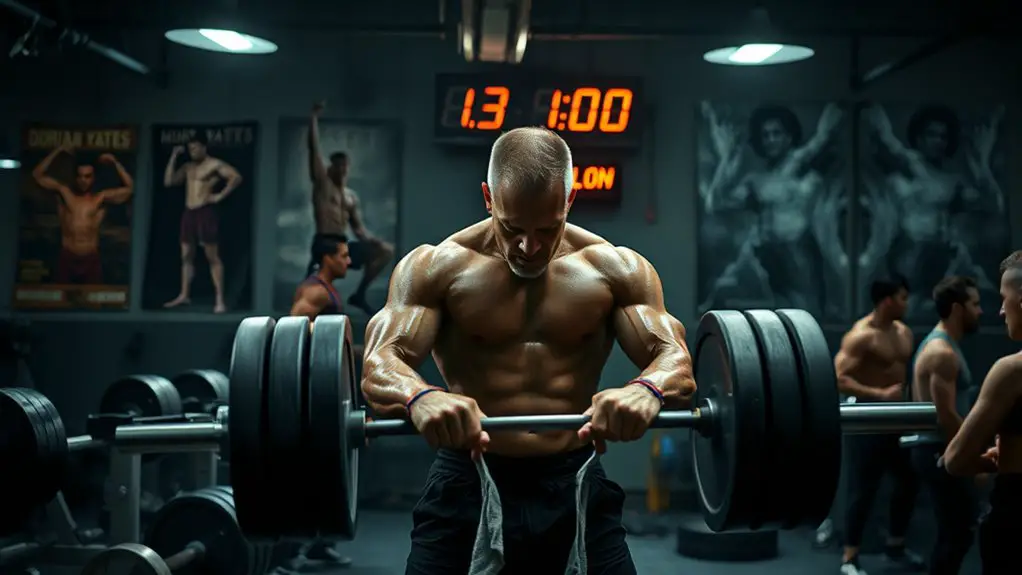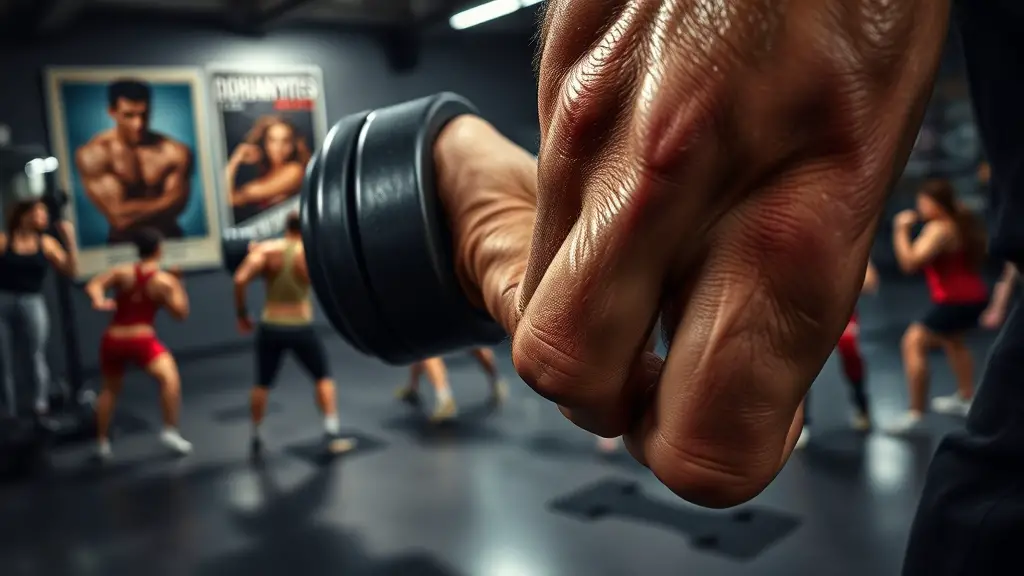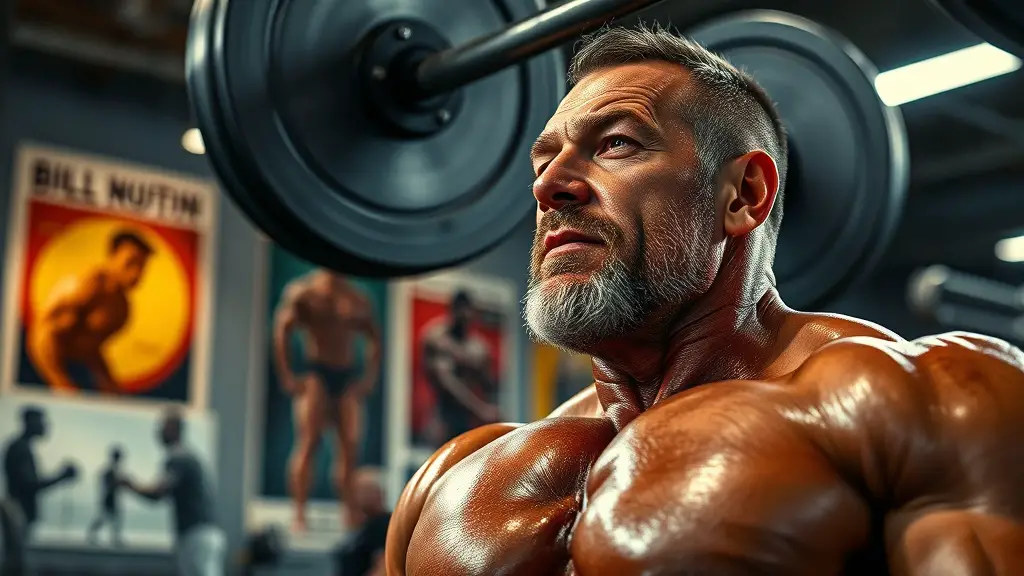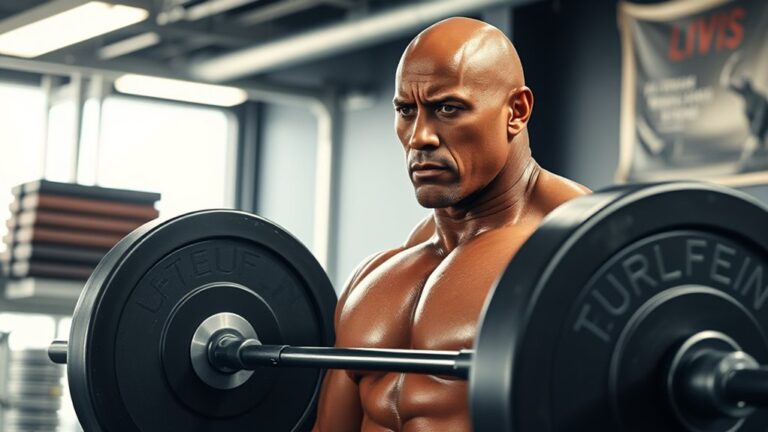How Dorian Yates’ HIT Training Revolutionized Gym Workouts

Dorian Yates’ High-Intensity Training (HIT) revolutionized gym workouts by emphasizing intensity over volume. Instead of long sessions, Yates focused on fewer, more intense sets, pushing you to muscle failure. This approach leads to efficient muscle activation and significant gains without the risk of burnout. You engage in controlled movements and proper form, enhancing strength and stability. If you want to explore how to effectively incorporate HIT into your routine, there’s much more to discover.
The Origins of High-Intensity Training

High-Intensity Training (HIT) emerged in the 1970s as a revolutionary approach to bodybuilding, fundamentally altering how people viewed strength training. It shifted the focus from volume to intensity, emphasizing shorter, more intense workouts. This change was rooted in the foundational concepts of muscle failure and ideal recovery, which encouraged lifters to push their limits. Historical developments during this period, including the work of pioneers like Arthur Jones, laid the groundwork for HIT. Jones introduced machines that facilitated safer, more effective training, highlighting the importance of form and controlled movements. As the bodybuilding community began to adopt these principles, the narrative around strength training evolved. You’d find that HIT not only captured the attention of athletes but also challenged traditional methods, making it a lasting influence in fitness culture. Consequently, the origins of HIT set the stage for future innovations, including the philosophies of notable bodybuilders like Dorian Yates.
Key Principles of Dorian Yates’ Training Philosophy
While many training philosophies emphasize volume and frequency, Dorian Yates’ approach centers on the power of intensity and the significance of muscle failure. This mindset shift encourages you to prioritize quality over quantity in your workouts. Instead of endless sets, Yates advocates for fewer, more intense sets that push you to your limits.
Yates believes that achieving muscle failure is essential for training adaptation, as it forces your muscles to adapt and grow stronger. By focusing on this principle, you can maximize your efforts in the gym.
Additionally, Yates emphasizes the importance of proper form and controlled movements, ensuring that each rep is effective. This approach not only minimizes injury risk but also enhances the effectiveness of your training. Adopting Yates’ philosophy means embracing intensity, focusing on muscle failure, and ultimately transforming your workout experience for better results.
The Impact of HIT on Muscle Growth

When you think about muscle growth, consider how High-Intensity Training (HIT) emphasizes efficient muscle activation over sheer volume. By focusing on intensity, you might find that your workouts promote greater muscle engagement, leading to more significant gains. This approach challenges traditional methods, proving that sometimes less really is more in the quest for muscle growth.
Efficient Muscle Activation
As you plunge into the world of High-Intensity Training (HIT), you’ll quickly notice how it optimizes muscle activation for impressive growth. HIT’s emphasis on maximizing muscle recruitment during each set means you’re engaging more muscle fibers effectively. This targeted approach allows you to push your limits within fewer workouts, making each session count. With a reduced training frequency, you can provide your muscles ample recovery time, which is essential for growth. By focusing on high-quality reps and ensuring proper form, HIT not only enhances muscle activation but also prevents injuries. This method proves that intensity, rather than sheer volume, drives the most significant results, allowing you to sculpt a stronger physique in less time.
Intensity Over Volume
Understanding the significance of intensity in your workouts can revolutionize your approach to muscle growth. By focusing on intensity training instead of volume training, you’ll engage your muscles more effectively and stimulate growth. Here are some key advantages of prioritizing intensity:
- Maximized Muscle Fiber Recruitment: Higher intensity leads to greater activation of fast-twitch fibers.
- Increased Hormonal Response: Intense workouts boost testosterone and growth hormone levels.
- Efficient Time Management: Shorter, more intense sessions can produce similar or superior results to longer volume-focused workouts.
- Enhanced Recovery: Intensity training often requires less frequency, allowing better recovery.
- Mental Toughness: Pushing your limits builds resilience and determination.
Incorporating these principles can transform your training regimen and lead to significant muscle gains.
The Shift From Volume to Intensity
In Dorian Yates’ HIT training, there’s a clear shift from high volume to focused intensity, emphasizing minimal sets for maximum impact. This approach not only enhances training efficiency but also allows you to push your limits in a more targeted way. By concentrating on fewer, more intense workouts, you can stimulate muscle growth without the fatigue that often accompanies traditional volume training.
Emphasis on Minimal Sets
While many traditional training methods emphasize high volume and multiple sets to achieve muscle growth, Dorian Yates’ High-Intensity Training (HIT) flips this notion on its head by advocating for minimal sets that focus on maximizing intensity. This minimalist approach leads to more focused training, allowing you to push your limits effectively.
Here are some key benefits of emphasizing minimal sets:
- Enhanced focus on each lift
- Reduced workout time, making it more efficient
- Lower risk of overtraining
- Greater muscle engagement through maximum effort
- Increased mental toughness as you push your limits
Increased Training Efficiency
As you shift your focus from volume to intensity in your training, you’ll quickly discover that increased efficiency can lead to better results. Dorian Yates’ high-intensity training (HIT) methodologies emphasize fewer sets with maximal effort, reducing workout duration while enhancing muscle engagement. By concentrating on intensity, you’re not just saving time; you’re also stimulating muscle growth more effectively. This shift allows you to push your limits within a shorter timeframe, making every rep count. You’ll find that intense sessions often yield greater adaptations than longer, less focused workouts. As you adopt this approach, you’ll likely notice improved strength and muscle definition, confirming that quality often trumps quantity in your fitness journey. Embrace the intensity for peak gains!
Incorporating HIT Into Your Workout Routine

To effectively incorporate High-Intensity Training (HIT) into your workout routine, it’s important to first understand its core principles. This method focuses on maximizing effort in a shorter timeframe, which promotes significant training adaptation. Here’s how you can achieve successful workout integration:
- Choose compound exercises: Prioritize movements like squats, deadlifts, and bench presses to engage multiple muscle groups.
- Limit rest periods: Keep breaks between sets minimal to maintain intensity and stimulate muscle growth.
- Focus on form: Proper technique is essential to avoid injuries and guarantee you’re targeting the right muscles.
- Track progress: Regularly document your lifts and workout duration to identify improvements and adjust your routine.
- Listen to your body: Recovery is critical, so pay attention to how you feel and allow adequate rest when needed.
Common Misconceptions About HIT
What misconceptions do people often have about High-Intensity Training (HIT)? Many believe HIT’s intensity leads to overtraining, or that it’s only for advanced lifters. Myth debunking is essential here, as HIT can be effective for all fitness levels and is designed to maximize workout efficiency in a shorter time.
Here’s a breakdown of common myths:
| Myth | Reality | Impact on Training |
|---|---|---|
| HIT causes overtraining | Proper recovery is emphasized in HIT | Prevents burnout and injuries |
| Only for experienced lifters | Beginners can adjust intensity levels | Makes HIT accessible for everyone |
| Requires long workouts | Short, intense sessions are the goal | Saves time while promoting results |
| It’s just about lifting heavy | Focuses on form and controlled movements | Enhances overall strength and stability |
Additionally, beginners should always respect personal limits to avoid burnout while practicing HIT.
The Legacy of Dorian Yates in Modern Bodybuilding

Dorian Yates revolutionized modern bodybuilding not just through his impressive physique, but by introducing High-Intensity Training (HIT) as a legitimate and effective training methodology. His methods greatly shaped the bodybuilding evolution we see today, and Dorian’s influence can be felt in various aspects:
- HIT emphasizes quality over quantity, pushing limits in fewer sets.
- Athletes prioritize recovery, leading to smarter training regimens.
- The focus on mental intensity has become a staple in gym culture.
- Bodybuilders now embrace a more holistic approach to fitness, including nutrition and mental well-being.
- Dorian’s legacy inspires both seasoned pros and newcomers to challenge traditional norms. Understanding workout intensity is crucial for maximizing the effectiveness of HIT training.
Success Stories: Athletes Who Embraced HIT
While many athletes have found success through traditional training methods, those who embraced High-Intensity Training (HIT) often report transformative results that go beyond mere aesthetics. Athlete testimonials highlight incredible training transformations, showcasing not just improved physiques but enhanced performance and mental resilience.
Take, for example, a competitive bodybuilder who shifted to HIT after years of conventional routines. He experienced greater muscle gains in less time, allowing him to focus on recovery and overall health. Similarly, powerlifters have noted how HIT’s intense, brief sessions lead to increased strength without the burnout associated with longer workouts.
These success stories aren’t just anecdotal; they underscore a shift in mindset. Athletes who adopt HIT often find they can push their limits further, leading to unprecedented personal records. Additionally, incorporating exercises like jump rope can provide an excellent cardiovascular workout, enhancing overall fitness. Ultimately, embracing HIT not only revolutionizes their training approach but also cultivates a deeper connection to their athleticism.
Frequently Asked Questions
What Equipment Do I Need for HIT Training?
When you’re diving into HIT training, you’ll find that the right equipment can enhance your workouts considerably. While some believe you need a gym full of machines, you actually don’t. Dumbbell exercises, resistance bands, and bodyweight workouts can deliver excellent results. Gym machines can also be useful, but they’re not essential. Prioritize versatility and convenience in your gear; this way, you can effectively engage different muscle groups and keep your training dynamic and effective.
How Often Should I Train Using HIT Principles?
When it comes to HIT frequency, it’s essential to find a balance that works for you. Generally, training 2-3 times a week can be effective, allowing for adequate recovery periods. Since HIT involves high intensity, your muscles need time to repair and grow stronger. Listen to your body; if you’re feeling fatigued or sore, consider taking an extra rest day. This approach guarantees you maximize your results and minimize the risk of injury.
Can Beginners Safely Start With HIT Workouts?
Yes, beginners can safely start with HIT workouts by incorporating beginner modifications and following essential safety precautions. Start with lighter weights and focus on form to prevent injury. Gradually increase intensity as you build strength and confidence. It’s vital to listen to your body and allow adequate recovery time. By prioritizing safety and making necessary adjustments, you can enjoy the benefits of HIT training while minimizing the risk of overexertion or strain.
What Are the Signs of Overtraining in HIT?
If you’re doing HIT workouts, watch for signs of overtraining. Common fatigue symptoms include persistent soreness, irritability, and decreased performance. You might also notice trouble sleeping or increased heart rates. To combat this, implement recovery strategies like incorporating rest days, proper nutrition, and hydration. Listen to your body; if you’re feeling exhausted, don’t hesitate to pull back. Recognizing these signs early can help you maintain your training intensity without compromising your health.
How Does Nutrition Complement HIT Training for Best Results?
Nutrition’s like the engine oil in your workout machine; without it, things grind to a halt. To maximize your HIT training results, focus on nutrient timing and meal planning. Consuming protein and carbs shortly after your workouts helps repair muscles and replenish energy stores. Pre-workout meals provide you with the necessary fuel, while well-planned meals throughout the day guarantee your body’s constantly primed for recovery and growth. Stay consistent, and you’ll see the benefits!





